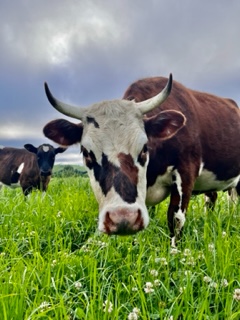Cows tend to grow horns. They are all wildly different, just like their personalities. Current practice is to chop them off or disbud them while the calf is very young. It is obvious why; a 600 plus kg animal with sharp things growing out its head can present a few difficulties. Once when a gentleman was coming out to do a homekill for us he was a bit late because he had to shoot a whole herd of cattle. They were Angus crossed with Highland and not only had they grown massive weapons on their heads they were also very temperamental. One of them had put the farmer in hospital the day before so the whole lot was condemned.
When it came to my cattle I wasn’t sure what to do. The first few herds had been disbudded with the ones that still managed to grow horns having them chopped off. It doesn’t hurt them I was told as I watched blood spurt across the yards. It just didn’t feel right to me, although I understand the danger they can present.
Currently in New Zealand local anaesthetic must be used when either disbudding (application of caustic paste or an electric/gas hot iron to destroy the horn producing cells when the calves are a few days old) or dehorning. Contrary to old held beliefs, it is painful.
As the intention for my cattle was to be killed onsite and not go on the truck to the abattoir I felt I didn’t need to take their horns off. I dithered about trying to gather other people’s points of view. I have a very gentle friend who milks her own Jersey (a noticeably temperamental breed) who has huge horns. She felt removing the horns was taking something from the animal, part of its identity. Then I went to speak to Biddy, a legendary cheesemaker in Eketahuna, who made her cheese from a small herd of cows she milked herself “get em off” she told me in no uncertain terms. Mine not being milking animals, the problem only presents itself when we’re drenching them and moving them and so far they have all been gentle beings. The potential for them to damage each other is also a concern.
I have a friend who does all the research before she moves forward with anything. A highly intelligent information gatherer who is almost expert before she begins. I admire her. I just crack on with what I feel I should do, often without any actual knowledge or reason. Then I bob about on a sea of uncertainty, hoping I will bump into something I can anchor myself to.
That was the case with the direction I had taken until I bumped into Dr Mari Stewart and here my anchor now rests. An incredible woman whose career has been dedicated to raising animal welfare and was involved in bringing the legislation in, in 2019 regarding the removal of horns.
I spent a wonderful hour picking her brains about dehorning, castrating and transport (another huge concern for me)
When we started on my complete cow journey its principles were based around a holy trinity of a good life, a good death and using every part of that animal respectfully. As things have panned out I have only managed the first one, so far.
Marie (an animal welfare scientist) explained that prior to the legislation coming in, disbudding and dehorning in young calves could be done without any pain relief just as castration is now in calves under 6 months. This is currently also under review.
Castration on farm is the same for sheep and cattle. Tight rubber rings are placed around the balls which slowly cuts off the blood supply until they fall off. I had always been told this did not hurt and was merely uncomfortable until it went numb. Again this didn’t feel right to me after watching the animals limp away afterwards. Marie believes that calves of all ages should be given pain relief and after hearing this its what we will be doing from this day forward.
We finally discussed the transportation of stock around NZ. It’s an area of great concern for her as it is for me and it was good to hear that this is being looked at as well. Being loaded onto a truck and driven for ks is obviously stressful for an animal that has spent its whole life outside in a paddock. But in addition to this different herds are mixed up and this co- mingaling is incredibly stressful for cattle as they form very strong bonds with each other (I’ve witnessed this when I have to load an animal onto the truck, the ones that are left behind pace along the fence and below for it, sometimes for hours).
The other problem is that the trucks are aging and no longer fit for purpose with many of them too small to accommodate the cattle adequately and they can suffer back rub which can be painful. All this before they arrive at the works, get put into a pen and await their turn to go in. Not only is this a terrible end for an animal it also can affect the quality of the meat with adrenaline being constantly pumped around the body.
Meeting with Marie was not only inspirational, it solidified my beliefs that I’m on the right track and given me increased vigor to push forward with our licenced on sight slaughter as I know it’s the right thing to do for not only our animals but all the wonderful subscribers who care about where their meat comes from, how it’s cared for and the process it’s taken to getting on to their plate.
Jurys still out on whether I keep the horns on or not…….
Claire x


Here is a comment. Let me know if you get this.